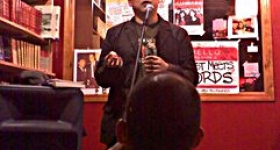Matthew Salesses is the author of a novel, I’m Not Saying, I’m Just Saying; a novella, The Last Repatriate; two ebooks, Different Racisms and the forthcoming All-American Bear Terrorizes Canada, both from Thought Catalog Books; and two chapbooks, Our Island of Epidemics and We Will Take What We Can Get. He talked with Hyphen's Nicole Chung about Different Racisms, which was published on April 28.

NC: How did you come to write Different Racisms?
Matthew Salesses: I had help. Mink Choi at Thought Catalog was kind enough to ask if I had anything for an ebook. I had written three essays on racism and Asian American stereotypes (or, as I like to think about them, two essays on Jeremy Lin and one essay on Psy) for The Rumpus, thanks to encouragement from Roxane Gay. I sent Mink these three. Later, when I was doing edits, I felt as if I needed another to round them out, so we included a fourth essay that had been published in the AAWW’s The Margins. I wrote something like 80 footnotes that included anecdotes, more arguments, reflection on the essays, and so on.
As for how I came to write the individual essays, mostly I got upset about something. Many of my essays start with my reaction, and get written if the reaction is sustained and complicated and relatable. I was seeing some of my own personal struggles with racism mirrored in public discourse about Jeremy Lin, Asian Americans, and how Asian men in particular are perceived. Due in part to the model minority stereotype, and other perceptions about Asians, I think racism against us is often misunderstood or more accepted.
Is there one essay in particular that means the most to you?
The first essay, probably. What I wrote about for that essay were the things that hurt just beneath the surface. Those were the stories and emotions that came out first, and the ones I still feel the deepest. I think if I hadn’t written that essay, and maybe even if the response hadn’t been so amazing, I might not have gone on to write the others.
In the book, you mention that you used to write only white characters. Why do you think you did that?
Part of it is representation — based on what I read growing up, I thought for a long time that if I wanted to be a writer, I would have to write about white people, or at least for a mainly white audience. I thought those were the kinds of books that got read and published. There was also a level of not wanting to be labeled [as an ethnic writer], which I know other writers of color worry about as well.
I’ve learned something about myself. I am able to write more honestly about my characters and the issues they encounter now. But it keeps surprising me how much I still write with a mostly white audience in mind. I was just reading over some stories I wrote for a hopeful fiction collection. None of them were written that long ago, and they were still aimed at white readers on some level, and I could see that concern for audience, at times, standing in the way of honesty.
I’ve realized that when I write fiction, I am often imagining a white reader at some point in the process, whether as agent or editor, and that filter affects the way I write. When I write nonfiction, maybe I picture somebody more like myself, whom I can reach directly. That may be part of the reason why some of the essays in Different Racisms came more quickly for me than with fiction — I was thinking of readers who are already more in my position and don’t need as much filtering.
Have you been following the #WeNeedDiverseBooks movement? What do you think we can do to make sure all the talk leads to change?
People say the way to sell your book is to find that person, that agent and then that editor, who is the right fit for your book. But that becomes infinitely harder when there are so many publishers whose backgrounds, areas of expertise, and typical audiences might not be that diverse.
The Rumpus, so dear to my heart, recently linked to an article arguing that readers of color need to buy diverse books if they want things to change. I don’t like that. I don’t think the burden should be on readers of color to change a system in which they are not sold to, in which they are not well-represented or understood. A diverse audience is out there and, in my experience, eager. The industry needs to shift the way it thinks about reaching that audience, and part of that is in putting the onus on itself.
Writing can be such a solitary endeavor. Where do you find your community?
It can be hard to find a place where people are willing to put themselves on the line like you need to have a real sense of community. If you’re coming from a less empowered background, it can be even harder. It can be lonely to be a writer of color. I feel connected with a lot of Korean American writers and adoptee writers, even without a lot of direct contact. I feel inspired knowing that those other voices are out there.
I like Twitter because real emotions seem to be on display there more than they are in other forms of social media. It helps to know there are people out there who are upset about the same things you’re upset about; passionate about the same things you’re passionate about.
You’ve written both fiction and nonfiction. What do you particularly like about writing essays like the ones in Different Racisms?
I like to read essays in which the writer starts in one place and ends in another. It’s like watching someone think, seeing how their mind operates. And I often feel like there’s a point in an essay where, if it’s working, I feel like I am with the author. So that’s part of what I was trying to do in my essays — just be open and give that level of access to the reader. Show the struggle on the page so that others can come along and experience it.
I think that good essays can change people’s minds, but also that it’s really hard to do. You can do it if you get someone to not just think like you, but to feel like you. On some level, when I write essays, I’m trying to shift people’s perceptions just a bit. If you can do that a little, and then the next story or conversation or movement does it a little, then you can start to gain momentum and hopefully see some change.
***
Matthew Salesses is the author of a novel, I’m Not Saying, I’m Just Saying; a novella, The Last Repatriate; two ebooks, Different Racisms and the forthcoming All-American Bear Terrorizes Canada, both from Thought Catalog Books; and two chapbooks, Our Island of Epidemics and We Will Take What We Can Get. Follow him on Twitter.









Comments